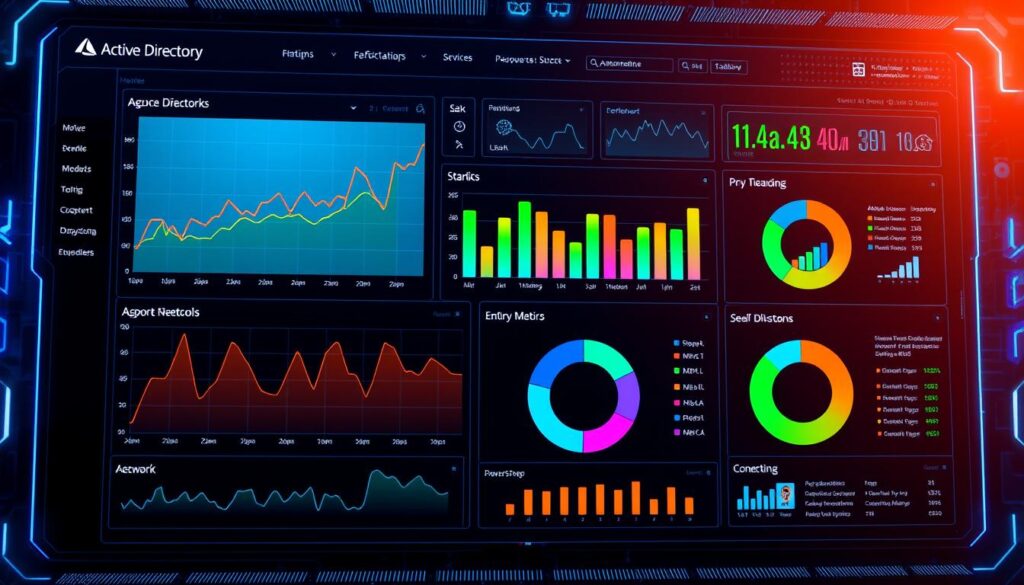Comprehensive Guide to Monitoring Azure Active Directory Health and Performance

Did you know over 90% of big companies use Microsoft Azure Active Directory for managing user identities? This platform is key for keeping things secure and running smoothly. Monitoring Azure Active Directory health and performance is now a must for keeping everything working well and protecting important data.
With many Azure AD monitoring tools out there, you can keep an eye on important metrics. These metrics show how your environment is doing, from user logins to password resets.
Knowing how to do an Active Directory health check is important. It helps you fix problems early on. This guide will help you learn how to use monitoring tools and find the right metrics to watch. With this knowledge, you can make sure everything is in line, improve user experiences, and keep your cloud environment safe.
Introduction to Azure Active Directory
Azure Active Directory (AAD) is Microsoft’s advanced cloud-based directory and identity management service. It evolved from traditional on-premises Active Directory. Now, it’s designed for cloud applications and services.
This modern solution makes identity and access management easy for many applications. It helps integrate cloud-based and on-premises resources smoothly.
Knowing the Active Directory definition is key to understanding Azure AD. It’s not just a secure identity solution. It also offers single sign-on, multi-factor authentication, and identity protection.
These features are essential for secure access to various applications in Azure. Azure Active Directory is a must-have for modern IT infrastructure.
Organizations using Azure Active Directory need to watch out for rapid user account growth. This growth increases the risk of cyber threats like ransomware and password spraying.
Regular auditing and following industry regulations are vital. Azure monitoring tools can help with these tasks. The default data retention period for Azure logs is short, so organizations must plan for long-term data storage.
Azure monitoring tools offer unique solutions for the cloud environment’s complexities. These tools, along with third-party options, have different costs and scalability. This can affect an organization’s budget.
Effective monitoring is not just technical. It’s a critical business strategy. It ensures Azure services operate smoothly, which is important for those using Office 365 heavily.
Why Monitoring Azure Active Directory Health and Performance is Essential
Azure AD health monitoring is key to keeping security and performance high. It ensures operations run smoothly. Active Directory Connect Health helps with this in big and spread-out setups, making it a must for Azure users.
It’s important to keep usernames and passwords in sync between local Active Directory and Azure AD. If this doesn’t happen, users face big problems. Without good Azure AD performance monitoring, users might not get to cloud services they need. They might even have to ask IT for help.
Azure AD security is very important when it’s used everywhere. The Azure AD Connect Health portal gives insights into many things. This includes how well data moves between domain controllers and the cloud, and how well users can log in.
Putting the Azure AD Connect Health agent on each identity server makes things more reliable. This lets companies keep a close eye on their identity setup. With strong monitoring, users can easily get to both cloud and on-premises resources.
For better monitoring, having an Azure AD Premium subscription is a good idea. This subscription helps with health monitoring and following rules with detailed logs. By focusing on Azure AD performance, companies can avoid problems and create a safe, efficient place for users.
Key Features of Azure Active Directory Monitoring Tools
It’s key to know what Azure Active Directory (AD) monitoring tools can do. They help keep your security and performance top-notch. Tools like Azure Monitor offer great features. Third-party tools give even more insights into your Azure setup.
Azure Monitor: The Native Solution
Azure Monitor is Microsoft’s main tool for monitoring. It collects data from many areas, like apps and databases. It’s great for watching over your Azure resources.
Some of Azure Monitor’s best features are:
- Real-time analytics: Gives you quick insights into how things are running.
- Automated alerts: Sends you notifications when something important changes.
- Dashboards: You can make them your own to see what you want.
- Data collection rules: Makes it easy to set up how data is collected and used.
- Diagnostics and logs: Keeps a detailed record of what’s happening, like sign-ins and changes.
Third-Party Monitoring Tools for Azure AD
Some companies also use third-party tools to go beyond what Azure Monitor offers. Tools like eG Enterprise give a full view of your Azure and on-premises systems. Using these tools has many benefits.
- Comprehensive analysis: Gives deeper insights into how things are working.
- Custom analytics: Lets you make reports and dashboards that fit your needs.
- Integration with existing workflows: Works well with your IT systems.
- Enhanced reporting: Helps with audits and keeping things secure.
These tools make monitoring easier and faster. They help spot and fix problems quickly. It’s smart to look at both Azure Monitor and third-party tools to create a strong monitoring plan.
Understanding Azure AD Performance Metrics
Monitoring Azure Active Directory (Azure AD) performance is key to a safe and efficient setup. By looking at these metrics, you learn about user actions, find performance issues, and spot security risks. Tracking different metrics helps manage Azure user identity well, making sure systems run smoothly.
Common Performance Metrics to Monitor
There are several important metrics to watch when checking Azure AD. These include:
- User sign-in success rates
- Failed login attempts
- Latency in authentication responses
- Account lockouts
- Number of active users
Collecting Azure AD access logs with these metrics gives a full view of your identity performance. This data helps manage user identity better, improving Azure performance overall.
Using Azure AD Metrics for Performance Optimization
Using Azure AD performance metrics helps improve systems. By spotting trends in user access, you get the insights needed for Azure AD optimization. Metrics like average response times and sign-in durations guide decisions on user experience and system speed.
Regularly checking these metrics supports ongoing improvement. It helps make security settings better. Also, it makes resource allocation smarter, creating a safe space that meets user needs.

Implementing an Azure AD Health Check
Running an effective Azure AD health check is key to keeping your organization’s performance and security top-notch. This process includes several important steps to make sure your Active Directory health monitoring is strong. Regular Azure AD checks help spot risks early and help manage them proactively.
Steps for Conducting a Health Check
To check Azure Active Directory’s health, follow these steps:
- Gather Performance Metrics: First, collect important performance metrics. This data is essential for AD health diagnostics.
- Review Audit Logs: Look at audit logs to find unusual activities that might show problems.
- Assess User Sign-Ins: Check user sign-in patterns to find any authentication issues.
- Analyze System Alerts: Keep an eye on system alerts, as they can show service disruptions that need fixing.
- Establish a Baseline: Compare current metrics to historical data to understand normal performance and spot any changes.
By following these steps, you can catch any performance drops early. This means you can fix problems quickly.
Automating Health Checks with Azure Monitor
Automating health checks makes monitoring Azure AD more efficient. Azure Monitor automation lets IT teams set up alerts based on Azure AD conditions. This way, you get alerts right away when big issues happen.
Azure Monitor can also work with Azure AD monitoring tools to offer:
- Real-time alerts on service outages.
- Emails for critical performance issues.
- Deep analytics to track performance trends over time.
Automated health checks help ensure users can access their resources smoothly. They also reduce the risk of disruptions. With tools like Azure AD Connect Health, you can keep an eye on synchronizations and get alerts for any problems.
| Step | Description | Outcome |
|---|---|---|
| Gather Performance Metrics | Collect data related to user activity and system performance. | Baseline established for monitoring. |
| Review Audit Logs | Examine logs for signs of anomalies. | Alerted to suspicious activities. |
| Assess User Sign-Ins | Monitor access records for trends. | Identification of authentication issues. |
| Analyze System Alerts | Track alerts related to service health. | Timely response to service disruptions. |
| Establish a Baseline | Compare current performance to historical data. | Detection of abnormal performance trends. |
Best Practices for Azure AD Monitoring
Monitoring Azure Active Directory is key for security and efficiency. Using best practices for alerts and visualization makes monitoring better.
Setting Up Alerts and Notifications
Azure AD alerts are important for early detection. Start with an Azure Monitor notification setup that fits your needs. Set up alerts for things like login failures or unusual access.
This helps your IT team act fast on security threats.
- Use free Azure Monitor alerts for cost-effective monitoring.
- Reduce log search alerts to save money without losing effectiveness.
- Use machine learning for dynamic thresholds to avoid fixed values.
- Manage encryption with customer-managed keys for better security.
- Secure alert notifications with webhook actions.
Utilizing Dashboards for Visibility
Azure AD monitoring dashboards show health and performance in real-time. Customize these dashboards to highlight important metrics like user activity and failed sign-ins.
This lets admins quickly address issues, making monitoring more effective.
- Use Azure metrics visualization for better dashboards.
- Integrate Azure Logic Apps for smoother alert workflows.
- Be careful with monitoring roles to keep security tight.
- Focus on success to avoid alert fatigue and improve response.

Challenges in Monitoring Azure Active Directory
Monitoring Azure Active Directory has its own set of challenges. One big issue is integrating with on-premises Active Directory services via Azure AD Connect. This makes it harder to see and fix problems, creating Azure AD monitoring challenges. It’s key to understand these complexities to keep user experience smooth.
The complexities in monitoring Azure resources lead to a lot of data. This makes it hard to cover everything in monitoring. High data volumes can hide important performance metrics, making it tough to spot issues fast. For example, Azure AD Connect Health issues have been reported, even with updates like .NET Framework ones.
Azure AD Connect version 1.1.880.0 auto-upgrades, but updates are slow. This means users wait for updates to monitor effectively. Such problems can make accounts out of sync, hurting workflows. The need for a solid monitoring plan is clear, given these ongoing issues.
To tackle these challenges, consider a systematic approach outlined in the table below:
| Challenge | Description | Potential Solution |
|---|---|---|
| Integration with On-Premises Active Directory | Complicated visibility and troubleshooting. | Utilize advanced monitoring tools to enhance visibility. |
| High Data Volume | Obscures critical performance metrics. | Implement data filtering and prioritization strategies. |
| CPU Performance Issues | Spikes in usage lead to system disruptions. | Regularly monitor and optimize .NET Framework versions. |
| Delayed Updates | Users left waiting for effective monitoring enhancements. | Establish a proactive update management process. |
By tackling these monitoring challenges, organizations can use Azure AD better. This ensures a safe and reliable space for their users.
Conclusion
Effective Azure AD monitoring is key to a secure and efficient cloud setup. Using Azure Monitor and third-party tools gives you a full view of your Azure Active Directory metrics. This summary of Azure AD performance management shows why tracking metrics and following best practices are important.
By setting up alerts, automating tasks, and doing regular health checks, you can boost your security. You also make sure you follow industry standards. Using log insights and real-time monitoring helps find and fix security issues before they become big problems.
Being proactive in Azure AD monitoring makes managing your cloud easier and better for users. By following these steps, your organization can handle cloud identity management with confidence.
Source Links
- Active Directory Server Monitoring – Monitor Performance, Changes, and Health
- A Comprehensive Guide to Active Directory Monitoring Tools
- How to monitor Azure AD Step by Step | eG Innovations
- How to Monitor Microsoft Azure Active Directory (Azure AD)
- Introducing #AzureAD Connect Health for Windows Server AD | Microsoft Community Hub
- Azure AD Connect Health » ADMIN Magazine
- Azure AD Connect Health agent ? – Microsoft Q&A
- Azure Monitor overview – Azure Monitor
- What is Microsoft Entra monitoring and health? – Microsoft Entra ID
- What are Microsoft Azure monitoring tools?
- Keeping a watchful eye: A Deep Dive into Azure Monitoring
- Metrics in Azure Monitor – Azure Monitor
- Microsoft 365 management, reporting, and auditing – ManageEngine M365 Manager Plus
- Monitor your on-premises identity infrastructure and synchronization services in the cloud
- Best practices for Azure Monitor alerts – Azure Monitor
- Best practices for Azure AD B2C – Azure AD B2C
- Hybrid Active Directory Health Check: 5 Must-Know Tips for IT Administrators
- .NET update makes Azure AD Connect Health Sync Monitoring Service use high CPU
- What MSPs should know about Azure AD Monitoring | Sherweb
- Azure AD Connect Health – Troubleshooting Hybrid identity scenarios
- Monitoring and Security in Azure
- Azure AD RBAC Audit: Monitor and Analyze Azure AD
- Active Directory Health Check



